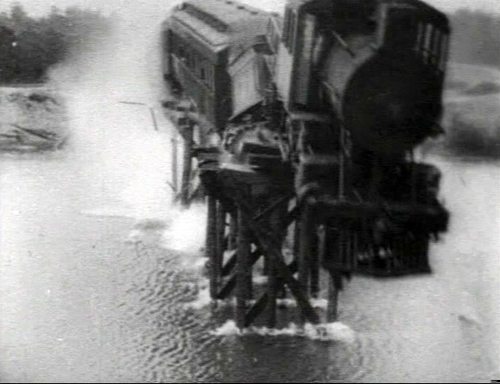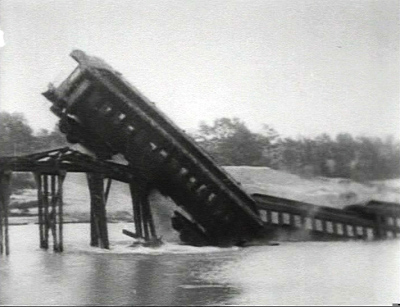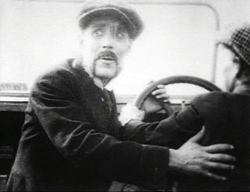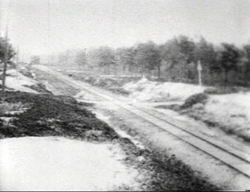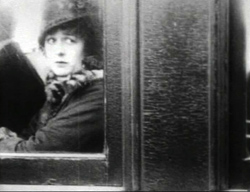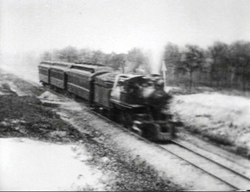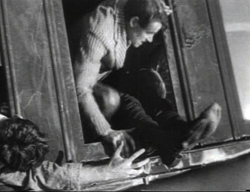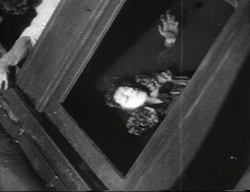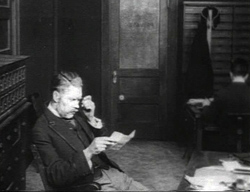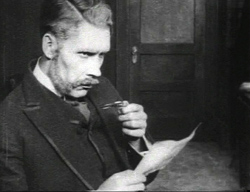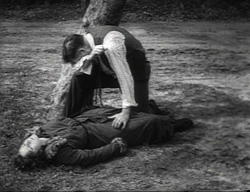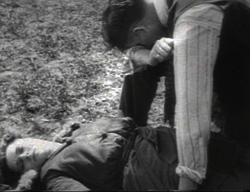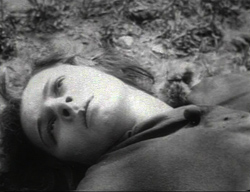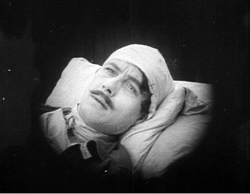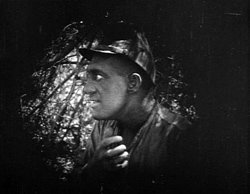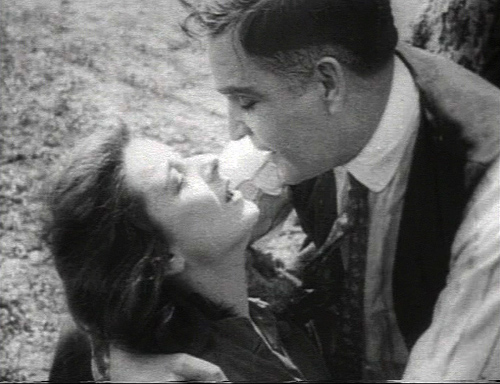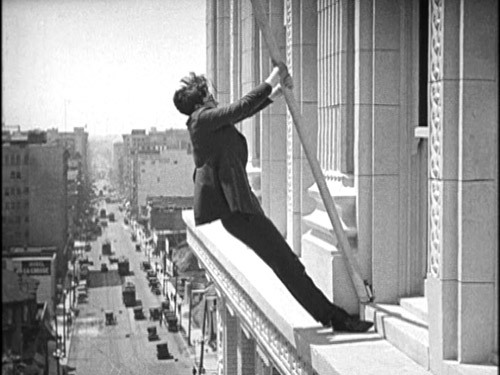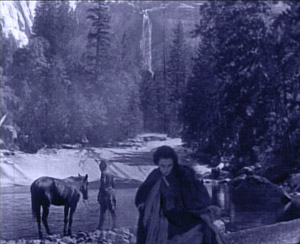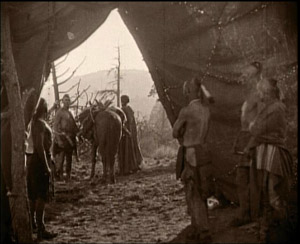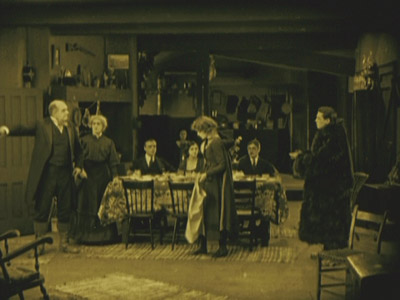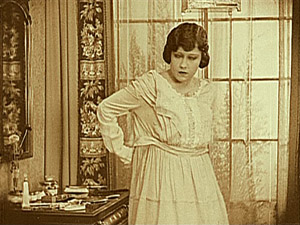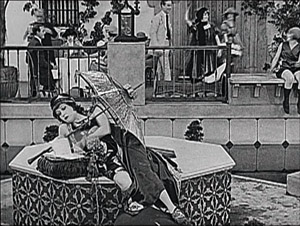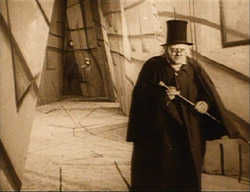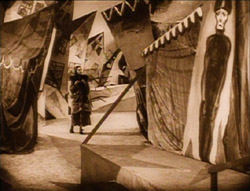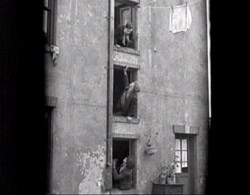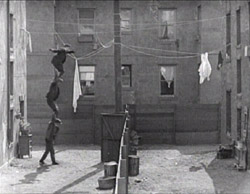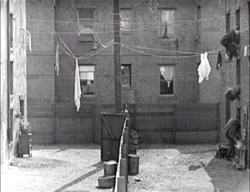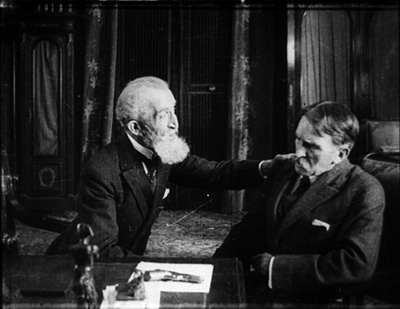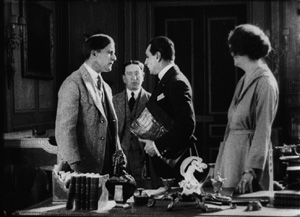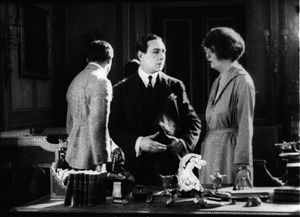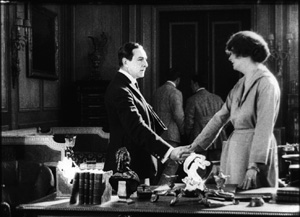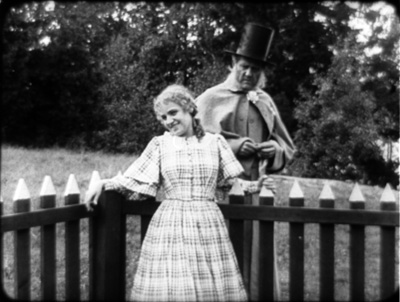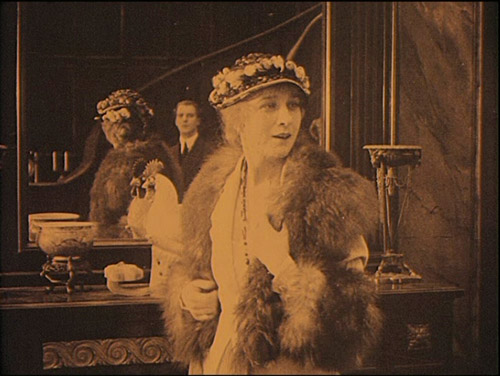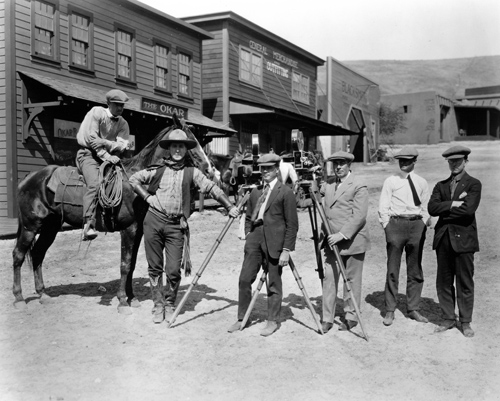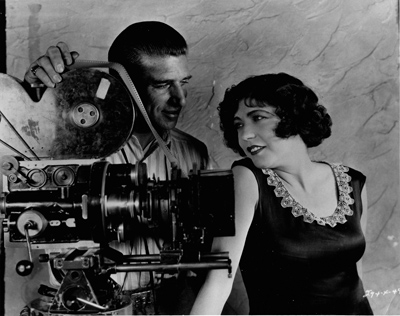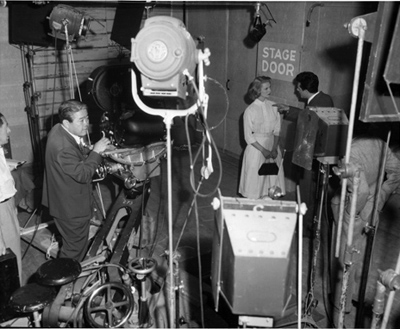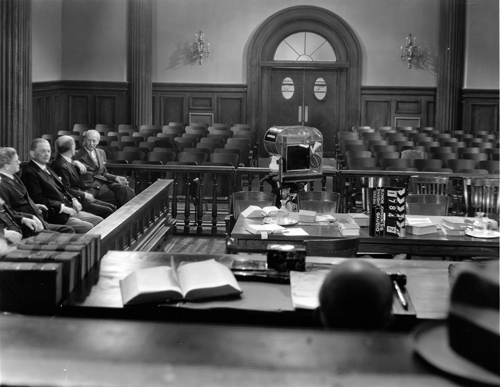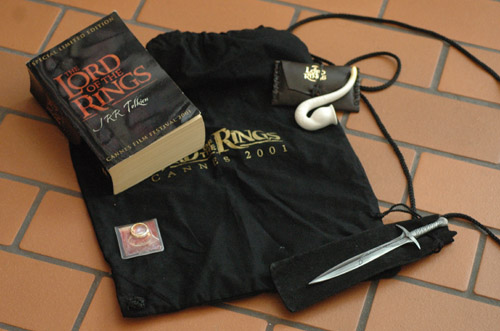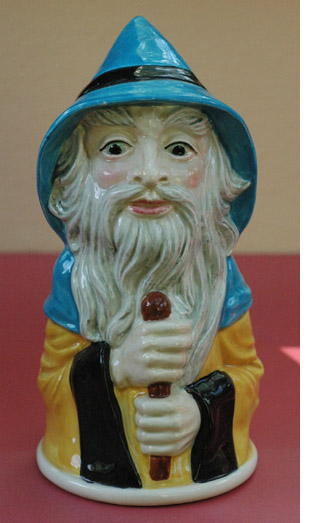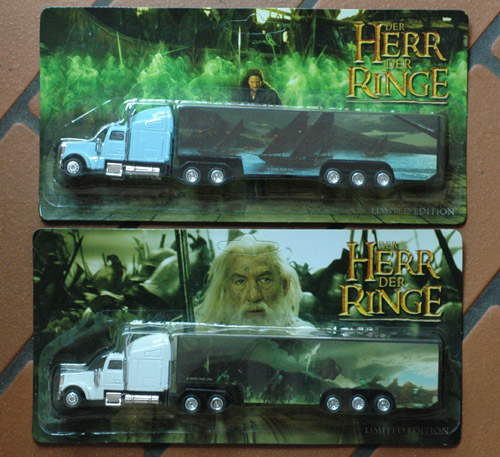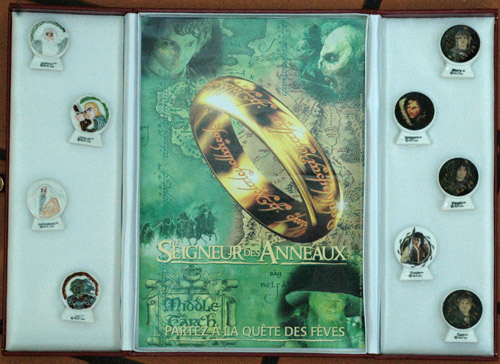Archive for the 'Film scholarship' Category
Back to the vaults, and over the edge
Unstoppable? Not really. The Juggernaut (1915).
DB here:
A few weeks ago, I praised Variety for making its back issues available digitally. The result is a magnificent vault of information. I also expressed frustration that the recent makeover of The Hollywood Reporter neglected to offer access to its original online archive, which indexed issues across the last twenty years. On the last point, some news.
First, my inquiry to the address listed on the HR website eventually yielded this blue note.
Good Morning,
We apologize for the delayed response.
I do not think there is a way to go back to prior to the changeover.
You would need to contact the publisher about that, as we do not handle the website directly.
Here is a phone number for you 323-525-2150.
Thank you.
I called the number, which handles only subscriptions, and the person answering had no idea what I was asking about.
But all is not lost. My first efforts to access the archive turned up very little for 2010, but shortly afterward I was able to access items from most of this year. Now, if you type a search term into the Search box of the HR site, it brings up items from as far back as 2008. This is an improvement over earlier attempts I made. It seems that THR is gradually adding old material to their archive, in reverse order.
Unfortunately, the search mechanism is quite indiscriminate. Searching “Johnnie To,” with and without quotation marks, yielded 290 hits, but I could find no articles about Johnnie To. Instead, the items with highest relevancy concerned Johnny Depp, Johnny English, John McCain, and the new Narnia movie.
The best news of all came from alert reader David Fristrom of Boston University. He advises me that the old HR archives are still available through LexisNexis. So I tried there with Johnnie To, and I got 338 references, stretching back to 1992. The ones at the top of the relevancy scale were indeed about Mr. To, including a Cannes piece called “Fest’s Red Carpet Flows with Blood.”
Accessing the archive isn’t straightforward, but you don’t need a subscription to HR if your library has purchased access to LexisNexis. I append David’s instructions at the end of this entry. Thanks to him for sorting this out for me.
Now, back into the Variety vaults.
This one’s a real train wreck
On 12 March 1915, Variety reviewed The Birth of a Nation. Alongside that review sits one of The Juggernaut, a Vitagraph feature directed by Ralph Ince. The reviewer, “Simc.,” dwells almost entirely on what he calls “the train-through-the-bridge thing.” The producers bought an old locomotive and some passenger cars, built a flimsy bridge, and ran their train off into what appeared to be a river.
The review exhibits some Variety touches that are still with us. Take the (quite reasonable) idea that nearly every movie is too long. “If this five-reeler were cut down to three reels, which could easily be done, the Vitagraph would have a real thriller.” There’s also the notion that people who come to the see the movie should be aware of its main attraction. “If the audience knows a train will go through a bridge at the finish, it won’t mind the fiddling about in the first four reels before that scene is reached. But if the audience doesn’t know what is to come, there may be many walk-outs.” At the beginning of Unstoppable we’ll sit through all the union and non-union wrangling and alpha-male preening if we’re sure we’re going to see a train that is certifiably unstoppable, except that it’s likely to be stopped by our heroes.
The Juggernaut does give us a pretty spectacular train wreck, as you see above. The entire film may not survive, but we have a version of the last reel (perhaps because a collector thought it worth saving). Train or no train, the film is of interest in showing what Griffith’s rivals were up to.
The plot centers on a crooked railroad magnate, Philip Hardin, and his college friend John Ballard. In the reel we have, Hardin’s daughter Louise, who loves John, sets out on an errand. When her car stalls she boards an express train. A track-walker finds worn ties on a bridge and warns the company, but too late. As Hardin races to stop Louise’s train, it arrives at the bridge and he watches it topple into the water. The sight kills him on the spot. John arrives and swims out to rescue Louise.
That’s when things get dicey. According to the Variety review and other sources, Louise dies in the wreck. Simc again:
The leading woman of the film, Anita Stewart, is discovered dead, lying against one of the windows, with particular pains taken that her features shall be clearly visible. . . . Anita is carried to shore and lain alongside of her father, who had died of heart failure (on land) a few moments before.
In the version available on DVD, John does bring her body ashore, but she revives, lifts herself up, and embraces him. The print ends there. Why the varying ending? Perhaps this is a version made at the time for a different market or in response to censorship, or it might be a rerelease using alternative footage. Or perhaps the press reviews were based on a synopsis supplied by Vitagraph, and the studio made modifications in the print before release.
The Juggernaut is also intriguing stylistically. By this point, crosscutting and scene analysis were common techniques in U. S. films. To set up the perilous situation, the cutting alternates shots of the track-walker, of Hardin, and of Louise. Once Hardin discovers that Louise is on the train headed for the dilapidated trestle, we are set up for a last-minute rescue–which fails. A particularly interesting series of shots shows Hardin’s trajectory converging with the train’s path. Riding in a power boat, Hardin looks back and we get a shot of the train in the distance, suggesting that he can see it.
From this we cut to a shot of Louise, confirming that she’s on board and showing her innocent lack of awareness. Then we get a repeated framing of the train rushing toward the bridge.
After another long shot of the train, we get a shot of Hardin in his powerboat with the train whizzing by in the background. This confirms that he was indeed watching it approach off screen left in the earlier shot, and it shows that he isn’t likely to catch up.
Once the train has toppled into the stream, there are some striking shots of people trapped inside or scrambling to escape. We see Louise raise one hand and then freeze, as if dying.
Earlier, there’s some emphatic “classical” cutting when Hardin learns that Louise is in danger. An enlarged framing (via an axial cut) underscores his reaction to the telegram.
Most striking is a series of shots of the dead-or-not Louise; the abrupt enlargement of her face has something of the force that Kurosawa would channel in his axial cuts.
Soon Ralph Ince cuts back along the same camera axis, and inward again as the couple embrace.
I can’t recall a comparable stretch of “concertina” cutting in the intimate scenes of Birth, and no such tight views of faces either. Griffith sometimes gives us “close-ups within medium-shots” by means of irising and vignetting.
Other directors (e.g., Dreyer) liked to use the serrated surround to highlight faces, but the American norm eventually became the unadorned closer view, as in the shot of Louise in The Juggernaut. Such shots probably saved production time as well. We’re confronted with the familiar situation that sometimes non-Griffith films from 1915 (e.g., The Cheat, Regeneration) look somewhat more “modern” than does Birth.
Going back to the train-through-the-bridge thing, the staging of the scene in late September 1914 elicited a lot of publicity. For one thing, the cost was played up; I’ve seen stories claiming $20,000, $30,000, and $50,000. The New York Times wrote up the shoot twice; the second of these could well be a publicity release from Vitagraph. According to the Times, the “river” was actually a flooded quarry. Before the shoot, buzz leaked out and crowds reported as numbering thousands showed up to watch. The crew spent hours herding them out of camera range. Actors were freezing in the water by the time cameramen got to take their shots. The Times also claims that the crash was filmed by fifteen (or twenty-five) cameras, a stupendously implausible number, especially in light of the footage we have. Worse, according to the second NYT story, Ince decided that the first pass didn’t work and they would have to start all over with a new train! A retake is not mentioned in Variety’s coverage, which does report some studio rivalry:
The ink on the New York dailies telling of the Vita’s big wreck stunt in the cameraing of “The Juggernaut” had hardly dried when the Universal sent over camera men posthaste Sunday to take views of what was left of the wreck. [Vitagraph studio manager Victor Smith], getting a hunch, got on the ground ahead of them and with a sturdy band of Vita “protectors” nipped the U’s little scheme in the bud.
One can only imagine how the “protectors” dealt with the Universal boys. Once more, the Variety Vault gives us the flavor, and perhaps sometimes the facts, of heroic times.
How to access the Hollywood Reporter archive, courtesy David Fristrom:
Once you are in LexisNexis, it can be a little tricky to search in The Hollywood Reporter (for some reason it doesn’t show up if you type “Hollywood Reporter” into the “Source Title” box), but you can follow these steps:
1. Click on “Power Search” in the upper-left corner.
2. On the “Power Search” page, find the “Select Source” box (near the bottom) and click on the “Find Sources” link.
3. On the “Find Sources” page, type “Hollywood Reporter” into the “Keyword” box and press enter.
4. At the top of the results should be “The Hollywood Reporter.”
Check the box next to it, then click on the “Ok-Continue” button that appears in the upper right corner.
5. You are now ready to search in the Hollywood Reporter archives –just type your search terms into the search box.
Thanks again to David!
The Variety review of The Juggernaut appears in the issue of 12 March 1915, p. 23. The story about Universal staff trying to shoot the wreckage is “Vita Putting It Over,” Variety, 10 October 1914, p. 23. The New York Times articles are “Film Train Wreck Almost a Tragedy,” NYT, 28 September 1914, p. 13, and “Tossing Dollars Around As If They Were Pennies,” NYT, 18 October 1914, p. X7. For more on Vitagraph, see Anthony Slide, The Big V: A History of the Vitagraph Company, rev. ed. (Metuchen: Scarecrow, 1987); Tony provides some production background on The Juggernaut on pp. 64-65.
The Juggernaut excerpt is available on Nickelodia 2, a DVD collection from Unknown Video. Oddly, the snapcase doesn’t list the reel as included on the disc, nor does the product information on the Unknown Video site or Amazon. I’d welcome more information about The Juggernaut‘s plot resolution if anybody out there has any.
The Juggernaut (1915).
The ten best films of … 1920
High and Dizzy
Kristin here:
Three years ago, we saluted the ninetieth anniversary of what was arguably the year when the classical Hollywood cinema emerged in its full form. The stylistic guidelines that had been slowly formulated over the past decade or so gelled in 1917. We included a list of what we thought were the ten best surviving films of that year.
In 2008 we again posted another ten-best list, again for ninety years ago. This annual feature has become our alternative to the ubiquitous 10-best-films-of-2010 lists that print and online journalist love to publish at year’s end. It’s fun, and readers and teachers seem to find our lists a helpful guide for choosing unfamiliar films for personal viewing or for teaching cinema history. (The 1919 entry is here.)
There were many wonderful films released in 1920, but, as with 1918, I’ve had a little trouble coming up with the ten most outstanding ones. Some choices are obvious. I’ve known all along that Maurice Tourneur’s The Last of the Mohicans (finished by Clarence Brown when Tourneur was injured) would figure prominently here. There are old warhorses like Das Cabinet des Dr. Caligari and Way Down East that couldn’t be left off—not that I would want to.
But after coming up with seven titles (eight, really, since I’ve snuck in two William C. de Mille films), I was left with a bunch of others that didn’t quite seem up to the same level. Sure, John Ford’s Just Pals is a charming film, but a world-class masterpiece? A few directors made some of their lesser films in 1920, as with Dreyer’s The Parson’s Widow or Lubitsch’s Sumurun. Seeing Frank Borzage’s legendary Humoresque for the first time, I was disappointed—especially when comparing it with the marvelous Lazy Bones of 1924. (Assuming we continue these annual lists, expect Borzage to show up a lot.) Chaplin didn’t release a film in 1920, and Keaton and Lloyd were still making shorts, albeit inspired shorts. Mary Pickford’s only film of the year, the clever and touching Suds, is a worthy also-ran. Choosing Barrabas over The Parson’s Widow or Why Change Your Wife? over Sumurun has a certain flip-of-the-coin arbitrariness, but we wanted to keep the list manageable. But they all repay watching.
The year 1920 can be thought of as a sort of calm before the storm. In Hollywood a new generation was about to come to prominence. Griffith would decline (Way Down East may be his last film to figure on our lists). Borzage will soon reach his prime, as will Ford. Howard Hawks will launch his career, and King Vidor will become a major director. The great three comics, Chaplin, Keaton, and Lloyd will move into features. In other countries, an enormous flowering of new talent will appear or gain a higher profile: Murnau, Lang, Pabst, Eisenstein, Pudovkin, Dozhenko, Kuleshov, Vertov, Ozu, Mizoguchi, Jean Epstein, Pabst, Hitchcock, and others. The experimental cinema will be invented, and Lotte Reiniger will devise her own distinctive form of animation. Watch for them all in future lists, which will be increasingly difficult to concoct
In the meantime, here’s this year’s ten (with two smuggled in). Unfortunately, some of these films are not available on DVD. They should be.
The great French emigré director Maurice Tourneur figured here last year for his 1919 film Victory. The Last of the Mohicans is just as good, if not better. I haven’t read the Cooper novel, set during the French and Indian War, but it’s obvious that Tourneur has pared down and changed the plot considerably. The sister, Alice, is made a less important character, with the plot focusing on two threads: the Indian attack on the British population as they leave their surrendered fort and on the virtually unspoken attraction between the heroine Cora and the Mohican Indian Uncas. The seemingly impassive gazes between these characters, forced to conceal their attraction, convey more passion than many more effusive performances of the silent period. The actress playing Cora also wore less makeup than was conventional, de-glamorizing her and making her a more convincing frontier heroine.
The film is remarkable for its gorgeous photography, with spectacular location landscapes, some apparently shot in Yosemite (below left). Tourneur’s signature compositional technique of shooting through a foreground doorway or cave opening or other aperture appears frequently (below right). (Brown’s account of the filming in Kevin Brownlow’s The Parade’s Gone By makes it sound as though he shot most of the picture, but in watching the film I find this hard to believe.)
Finally, the film stands out from most Hollywood films of its day for its uncompromising depiction of the ruthless violence of the conflict between the British and those Indians allied with the French. The scene in which the inhabitants of the fort leave under an assumed truce and are massacred can still create considerable suspense today, and the outcome puts paid to the notion that all Hollywood films end happily.
The word melodrama gets tossed around a lot, and many would think of much of D. W. Griffith’s output as consisting of little besides melodramas. But Way Down East is the quintessential film melodrama. An innocent young woman (Lillian Gish) is lured into a mock marriage and ends up deserted and with a baby. The baby dies and she finds a place as a servant to a large country family, where the son (Richard Barthelmess) falls in love with her. Her sinful status as an unwed mother leads the family patriarch to order her out, literally into the stormy night. She ends up on an ice flow, headed toward a waterfall. Along the way there’s comic relief from some country bumpkins and a naive professor who falls for the hero’s sister. It all works, partly because Griffith treats the main plot with dead seriousness and partly because Gish elicits considerable sympathy for her character.
Not only is it a great film, but it provides a window into the past, preserving a popular nineteenth-century play and giving insight into the drama of that era. It’s hard to think of another feature film that conveys such a genuine record of the Victorian theater, directed by a man who had made his start on the stage of the same period. (Unfortunately the film does not survive complete. The Kino version linked above is from the Museum of Modern Art’s restoration, which provides intertitles to explain what happens during missing scenes.)
Way Down East displayed a conservative attitude toward sex that was rapidly receding into the past–at least as far as the movies were concerned. The same year saw two films that set the tone for the Roaring ’20s in their more risqué depiction of romantic relationships: Cecil B. De Mille’s Why Change Your Wife? and Mauritz Stiller’s frankly titled Swedish comedy Erotikon.
De Mille has featured on our previous lists, for Old Wives for New in 1918 and Male and Female in 1919. Why Change Your Wife? ramped up the sexual aspect of the plot, however, as a Photoplay reviewer made clear: “”Having achieved a reputation as the great modern concocter of the sex stew by adding a piquant dash here and there to Don’t Change Your Husband, and a little more to Male and Female, he spills the spice box into Why Change Your Wife?” The plot is not nearly as daring as this suggests. Gloria Swanson plays a wife who is straight-laced and intellectual, driving her husband to spend time with a stylish woman who tries to seduce him. Yet he flees after one kiss, and after his wife divorces him on the assumption that he has cheated on her, he marries the seductress. The heroine discovers the error of her ways and becomes sexy in her dress and behavior. As a result the husband regains his old love for her, and they remarry. No actual adultery occurs, and the first marriage is affirmed with a happy ending.
Why Change Your Wife? may have seemed more daring because De Mille here externalizes the shifting relationships through the costumes to the point where no viewer could miss the implications. Initially the wife’s demure dresses mark her as prudish, while the woman who lures her husband away is dressed like a vamp. Once the wife lets go, she dons similar revealing, expensive designer clothes. As a result, the male members of the audience might revel in a fantasy of their ideal wife, and the women would delight in displays of fashions most of them could never own in reality. It proved a successful combination. We tend to forget it now, but the 1920s was full of variants and imitations of Why Change Your Wife?, often featuring a fashion-show scene that was nothing but a parade of models in outlandish clothes. (Early Technicolor was sometimes shone off in such sequences.) Top designers like Erté were recruited to bring their talents to such films.
Fashion as a selling point in films remains with us. The glossy new version of The Hollywood Reporter, recently decried by David, now has a regular “Hollywood Style” section. The November 24 issue ran “Costumes of The King’s Speech,” and the December 1 issue describes “Fashions of The Tourist,” with photos of Angelina Jolie in her various costumes. In addition to shots of the stars, both articles feature enticing close-ups of lipstick, shoes, jewelry,and purses.
A double feature of Why Change Your Wife? and Erotikon would provide a vivid sense of the differing moral outlooks of mainstream America and Europe in the post-war years. In Erotikon, the situation is reversed. An absent-minded entomologist neglects 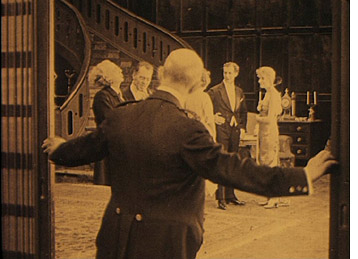 his sexy wife, who is having an affair with a nobleman. She is in love, however, with a sculptor, who is having an affair with his model. The sculptor returns her love, but eventually becomes jealous, not of her husband, who is his best friend, but of her lover. When the husband finds out that his wife has been unfaithful, he is mildly upset, but he settles down happily with his cheerful young niece, who pampers his taste for plain cooking and an undemanding home life. About the only thing these two films have in common is that they view divorce, which was still quite a controversial issue in the 1920s, as sometimes benefiting the people involved. Adultery actually occurs rather than being hinted at but avoided, though faithful monogamy is ultimately put forth as the ideal.
his sexy wife, who is having an affair with a nobleman. She is in love, however, with a sculptor, who is having an affair with his model. The sculptor returns her love, but eventually becomes jealous, not of her husband, who is his best friend, but of her lover. When the husband finds out that his wife has been unfaithful, he is mildly upset, but he settles down happily with his cheerful young niece, who pampers his taste for plain cooking and an undemanding home life. About the only thing these two films have in common is that they view divorce, which was still quite a controversial issue in the 1920s, as sometimes benefiting the people involved. Adultery actually occurs rather than being hinted at but avoided, though faithful monogamy is ultimately put forth as the ideal.
Erotikon reflects some of the influences from Hollywood that were seeping into European films after the war. Sets are larger, cuts more frequent (though not always respecting the axis of action), and three-point lighting crops up occasionally. Yet Stiller maintains the strengths of the Scandinavian cinema of the 1910s, with skillful depth staging (left) and a dramatic use of a mirror. In the opening of a crucial scene where the sculptor confronts the wife with her adultery, tension builds because she does not know he is watching her until she sees him in the mirror (see bottom). Still, apart from its European sophistication, Erotikon could pass for an American film of the same era. Stiller and lead actor Lars Hansen would both be working in Hollywood by the mid-1920s.
I can’t allow the nearly unknown director William C. de Mille to take up two slots this year, though it’s tempting. William’s career was shorter than that of his much better-known brother Cecil. It peaked in 1920 and 1921, though, and I still look back fondly on the films by him that were shown in “La Giornate del Cinema Muto” festival of 1991. That year saw a large retrospective of Cecil’s films, and the organizers wisely decided to include a 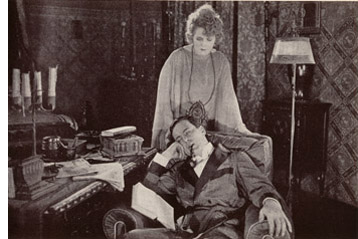 sampling of William’s surviving work.
sampling of William’s surviving work.
The two men’s approaches were markedly different. Where Cecil by this point was setting his films among the rich and using visual means like costumes to make the action crystal-clear to the audience, William was more likely to favor middle-class settings with small dramas laced with humor and presented with restrained acting and small props. Despite William’s skill as a director and his ability to create sympathy for his characters, he never gained much prominence, especially compared to his brother. He retired from filmmaking in 1932, at the relatively young age of 54. Yet obviously he was attuned to his brother’s style, having written the script for Why Change Your Wife? It may be characteristic of the two that Cecil capitalized the De in De Mille, while William didn’t.
Relatively few of William’s films survive, but these include two excellent films from 1920, Jack Straw and Conrad in Quest of His Youth. I don’t remember Jack Straw well enough to describe it. It involved the hero’s falling in love with a woman when they both live in the same Harlem apartment building. When her family becomes rich, Straw disguises himself as the Archduke of Pomerania in order to woo her. Sort of a Ruritanian romance but played out in the U.S.
I remember Conrad in Quest of His Youth better. The hero returns from serving as a soldier in India. He feels old and decides to try and recover his youth. The first attempt comes when he and three cousins agree to return to their childhood home and indulge themselves in the simple pleasures of their youth. Eating porridge for breakfast is a treasured memory, but the group discovers that this and other delights are no longer enjoyable to them as adults. Conrad goes on to seek romance elsewhere and eventually finds a woman who makes him feel young again. The film’s poignant early section manages in a way that I’ve never see in any other film to convey both nostalgia for the joys of childhood and the sad impossibility of recapturing them.
Neither film is available on DVD. Indeed, I couldn’t find an image from either to use as an illustration. The only picture I located is a rather uninformative one from Conrad in Quest of His Youth, above right, which I scanned from William C.’s autobiography (Hollywood Saga, 1939). It’s no doubt an indicator of William’s modesty that the frontispiece of this book is a picture of his brother directing a film.
Maybe this entry will serve as a hint to one of the DVD companies specializing in silent movies that these two titles deserve to be made available. They’re high on my list of films I would love to see again.
Most people who study film history see Das Cabinet des Dr. Caligari very early on, though they probably push it to the backs of their minds later on. I have a special fondness for Caligari precisely because I did see it early on. I took my first film course, a survey history of cinema, during my junior year. Maybe I would have gotten hooked and gone on to graduate school in cinema studies anyway, but it was Caligari that initially fascinated me. It was simply so different from any other films I had seen in what I suddenly realized was my limited movie-going experience. It inspired me to go to the library to look up more about it, a tiny exercise in film research.
Some may condemn it as stage-bound or static. Despite its painted canvas sets and heavy makeup, however, it’s not really like a stage play. Many of the sets are conceived of as representing deep space, though often only with a false perspective achieved by those painted sets:
Still, in an era when experimental cinema was largely unknown, Caligari was a bold attempt to bring a modernist movement from the other arts, Expressionism, into the cinema. It succeeded, too, and inaugurated a stylistic movement that we still study today.
I haven’t watched Caligari in years (I think I know it by heart), but I’m still fond of it. The plot is clever grand guignol. It has three of the great actors of the Expressionist cinema, Werner Krauss, Conrad Veidt, and Lil Dagover, demonstrating just what this new performance style should look like. The frame story retains the ability to start arguments. The set designs area dramatically original, and muted versions of them have shown up in the occasional film ever since 1920. Even if you don’t like it, Caligari can lay claim to being the most stylistically innovative film of its year.
As I did for our 1918 ten-best, I’m cheating a bit by filling one slot of the ten with a pair of shorts by two of the great comics of the silent period. Both have matured considerably in the intervening two years. In 1918, Harold Lloyd was still working out his “glasses” character. By this point he is much closer to working with his more familiar persona. Similarly, in 1918, Buster Keaton was still playing a somewhat subordinate role in partnership with Fatty Arbuckle. In 1920, he made his first five solo shorts, co-directing them with Eddy Cline.
The Lloyd film I’ve chosen is High and Dizzy, the second short in which he went for “thrill comedy” by staging part of the action high up on the side of a building. (See the image at the top.) Four years later he would build a feature-length plot around a climb up such a building in Safety Last, one of his most popular films. In High and Dizzy, Harold is not quite the brash (or shy) young man he would soon settle on as the two variants his basic persona. The opening shows him as a young doctor in need of patients. He soon falls in love with the heroine, and through a drunken adventure, ends up in the same building where she lies asleep. She sleepwalks along a ledge outside her window, and when Harold goes out to rescue her, she returns to her bedroom and unwittingly locks him out on the ledge. The film is included in the essential “Harold Lloyd Comedy Collection” box-set, or on one of the two discs in Kino’s “The Harold Lloyd Collection,” Vol. 2.”
Neighbors was the fifth of the five Keaton/Cline shorts made in 1920. (It was actually released in early 1921, but I’ll cheat a little more here; there are other Keaton films to come in next year’s list.) It’s a Romeo and Juliet story of Keaton as a boy in one working-class apartment house who loves a girl in a mirror-image house opposite it. Two bare, flat yards with a board fence running exactly halfway between them separate the lovers. Naturally the two sets of parents are enemies.
Lots of good comedy goes on inside the apartment blocks, but the symmetrical backyards and the fence inspire Keaton. We soon realize that his instinctive ability to spread his action up the screen as well as across it was already at play. The action is often observed straight-on from a camera position directly above the fence, so that we–but usually not the characters–can see what’s happening on both sides. For one extended scene involving policemen, Keaton perches unseen high above them, hidden. Even though we can’t see him, the directors keep the framing far enough back that the place where we know he’s lurking is at the top of the frame as we watch the action unfold. The playful treatment of the yard culminates in an astonishingly acrobatic gag that brings in Keaton’s early music-hall talents.
The boy and girl have just tried to get married, but her irate father has dragged her home and imprisoned her in a third-floor room. She signals to Keaton, across from her in an identical third-floor window. A scene follows in which two men appear from first- and second-story windows below Keaton, and he climbs onto the shoulders of the two men below. This human tower crosses the yard several times, attempting to rescue the girl; each time they reach the other side, they hide by diving through their respective windows:
They perform similar acrobatics on the return trips to the left side, carrying the bride’s suitcase or fleeing after her father suddenly appears.
Neighbors is included as one of two shorts accompanying Seven Chances in the Kino series of Keaton DVDs, available as a group in a box-set.
Our final two films lie more in David’s areas of expertise than mine, so at this point I turn this entry over to him.
DB here:
With Barrabas Feuillade says farewell to the crime serial. Now the mysterious gang is more respectable, hiding its chicanery behind a commercial bank. Sounds familiar today. As Brecht asked: What is robbing a bank compared with founding a bank?
Over it all towers another mastermind, the purported banker Rudolph Strelitz. In his preparatory notes Feuillade called him “a sort of sadistic madman, a virtuoso of crime . . . a dilettante of evil.” Against Strelitz and his Barrabas network are aligned the lawyer Jacques Varèse, the journalist Raoul de Nérac (played by reliable Édouard Mathé), and the inevitable comic sidekick, once again Biscot (so perky in Tih Minh).
The film’s seven-plus hours (or more, depending on the projection rate) run through the usual abductions, murders, impersonations, coded messages, and chases. But there’s little sense of the adventurous larking one finds in Tih Minh (1919), in which the hapless villains keep losing to our heroes. The tone of Barrabas is set early on, when Strelitz forces an ex-convict into murder, using the letters of the man’s dead son as bait. The man is guillotined. The epilogue rounds things off with a series of happily-ever-afters in the manner of Tih Minh, but these don’t dispel, at least for me, the grim schemes that Strelitz looses on a society devastated by the war. Add a whiff of anti-Semitism (the Prologue is called “The Wandering Jew’s Mistress”), and the film can hardly seem vivacious.
According to Jacques Champreux, Barrabas was the first installment film for which Feuillade prepared something like a complete scenario, although it evidently seldom described shots in detail. The film has a quick editing pace (the Prologue averages about three seconds per shot), but that is largely due to the numerous dialogue titles that interrupt continuous takes. With nearly twenty characters playing significant roles and some flashbacks to provide backstory, there’s a lot of information to communicate.
Of stylistic interest is Feuillade’s movement away from the commanding use of depth we find in Fantômas and other of his previous masterworks. Here the staging is mostly lateral, stretching actors across the frame. Very often characters are simply captured in two-shot and the titles do the work, as if Feuillade were making talking pictures without sound. Once in a while we do get concise shifting and rebalancing of figures, usually around doorways. Here Jacques vows to go to Cannes and tell the police of the kidnapping of his sister. As Raoul and Biscot start to leave, Jacques pivots and says goodbye to Noëlle, creating a simple but touching moment of stasis to cap the scene.
Full of incident but rather joyless, Barrabas will never achieve the popularity among cinephiles of the more delirious installment-films, but it remains a remarkable achievement. The ciné-romans that would follow until Feuillade’s death in 1925 would lack its whiff of brimstone. They would mostly be melodramatic Dickensian tales of lost children, secret parents, strayed messages, and faithful lovers. Barrabas is not available on DVD.
You might think that a movie that opens with a frowning old man studying a skeleton would also be somewhat unhappy fare. Such isn’t actually the case with Victor Sjöström’s generous-hearted Mästerman, a story of a village pawnbroker obliged to take a young woman as a housekeeper. With his stovepipe hat and air of sour disdain, Samuel Eneman, known to the village as Mästerman, is a ripe candidate for rehabilitation. Once Tora is installed and has put a birdcage (that silent-cinema icon of trapped womanhood) on the window sill, the scene is set for Mästerman’s return to fellow feeling. But she is there merely to cover the debts and crime of her sailor boyfriend, and eventually Eneman realizes he must make way for young love. The drama is played out in front of the townspeople, and as often happens in Nordic cinema (e.g., Day of Wrath, Breaking the Waves) the community plays a central role in judging, or misjudging, the vicissitudes of passion.
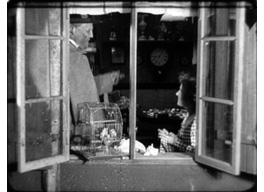 As a director Sjöström is a marvel. His finesse in handling the 1910s “tableau style” shines forth in Ingeborg Holm (1913), but unlike Feuillade and most of his contemporaries, he immediately grasped the emerging trend of analytical editing. His The Girl from the Marsh Croft (1917) and Sons of Ingmar (1918-1919) show a mastery of graded shot-scale, eyeline matching, and the timing of cuts. In Mästerman he continued to use brisk editing and close-ups to suggest the undercurrents of the drama. He moves people effortlessly through adjacent rooms, and his long-held passages of intercut glances recall von Stroheim. On all levels, Mästerman deserves to be more widely known–an ideal opportunity for an enterprising DVD company.
As a director Sjöström is a marvel. His finesse in handling the 1910s “tableau style” shines forth in Ingeborg Holm (1913), but unlike Feuillade and most of his contemporaries, he immediately grasped the emerging trend of analytical editing. His The Girl from the Marsh Croft (1917) and Sons of Ingmar (1918-1919) show a mastery of graded shot-scale, eyeline matching, and the timing of cuts. In Mästerman he continued to use brisk editing and close-ups to suggest the undercurrents of the drama. He moves people effortlessly through adjacent rooms, and his long-held passages of intercut glances recall von Stroheim. On all levels, Mästerman deserves to be more widely known–an ideal opportunity for an enterprising DVD company.
For a valuable source on Feuillade’s preparation for Barrabas and other of his works see Jacques Champreux, “Les Films à episodes de Louis Feuillade,” in 1895 (October 2000), special issue on Feuillade, pp. 160-165. I discuss Feuillade’s adoption of editing elsewhere on this site.
Tom Gunning provides an in-depth discussion of Sjöström’s style at this period in “‘A Dangerous Pledge’: Victor Sjöström’s Unknown Masterpiece, Mästerman,” in Nordic Explorations: Film Before 1930, ed. John Fullerton and Jan Olsson (Sydney: John Libbey, 1999), pp.204-231. For more on some of the directors discussed in this entry, check the category list on the right.
Erotikon.
What makes Hollywood run?
William S. Hart and crew at Inceville, 1910s.
DB here:
For decades most people had a sketchy idea of The Hollywood Studio Film. Boy meets girl, glamorous close-ups, spectacular dance numbers or battle scenes, happy endings, fade-out on the clinch. But even if such clichés were accurate, they didn’t cut very deep or capture a lot of other things about the movies. Could we go farther and, suspending judgments pro or con the Dream Factory, characterize U. S. studio filmmaking as an artistic tradition worth studying in depth? Could we explain how it came to be a distinctive tradition, and how that tradition was maintained?
In 1985 Routledge and Kegan Paul of London published The Classical Hollywood Cinema: Film Style and Mode of Production to 1960. Kristin, Janet Staiger, and I wrote it. Since it’s rare for an academic film book to remain in print for twenty-five years, we thought we’d take the occasion of its anniversary to think about it again. Those thoughts can be found in the adjacent web essay, where we three discuss what we tried to do in the book, spiced with comments about areas of disagreement and more recent thoughts. This blog entry is just a teaser.
A touch of classical
John Arnold, a Bell & Howell camera, and Renée Adorée in 1927.
The prospect of analyzing Hollywood as offering a distinctive approach to cinematic storytelling emerged slowly. The earliest generations of film historians tended to talk about the emergence of film techniques in a rather general way. For example, historians were likely to trace the development of editing as a general expressive resource, appearing in all sorts of movies. While they recognized that, say, the Soviet filmmakers made unusual uses of this technique, writers still tended to think of editing as either a fundamental film technique or a very specific one—e.g., Eisenstein’s personal approach to editing.
An alternative approach was to understand the history of film as an art as a stream of cinematic traditions, or modes of representation, within which filmmakers worked. From this angle, there was a Hollywood or “standard” or “mainstream” conception of editing, and this didn’t exhaust all the creative possibilities of the technique. But it went beyond the inclinations of any particular director. People had long recognized that there were group styles, like German Expressionism and Italian Neorealism, but it took longer to start to think of mainstream moviemaking as, in a sense, a very broad and fairly diverse group style.
In the late 1940s André Bazin and his contemporaries started to point out that different sorts of films had standardized their forms and styles quite considerably. Bazin attributed the success of Hollywood cinema to what he called “the genius of the system.” In my view, his phrase referred not to the studio system as a business enterprise but rather to an artistic tradition based on solid genres and a standardized approach to cinematic narration. This artistic system, he suggested, had influenced other cinemas, creating a sort of international film language.
The idea that there was a dominant filmmaking style, tied to American studio moviemaking, was developed in more depth during the 1960s and 1970s. Christian Metz’s Grande Syntagmatique of narrative film pointed toward alternative technical choices available in the “ordinary film.” Raymond Bellour’s analysis of The Birds, The Big Sleep, and other films pointed to a fundamental dynamic of repetition and difference governing American studio cinema. Somewhat in the manner of Roland Barthes’ S/z, Thierry Kuntzel’s essays explored M and The Most Dangerous Game looking for underlying representational processes that were characteristic of studio films. From a somewhat different angle, in the book Praxis du cinema and later essays Noël Burch traced out a dominant set of techniques that formed what he would eventually call the “Institutional Mode of Representation.” The Cahiers du cinéma critics famously posited different categories of filmic construction, each one tied to the representation of ideology. In English, Raymond Durgnat was an early advocate of studying what he called the “ancienne vague,” the conventional filmmaking that young directors were rebelling against.
The trend was given a new thrust by the British journal Screen, which disseminated the idea of a “classical narrative cinema,” a mode of representation characterized by distinctive dynamics of story, style, and ideology. Perhaps the most emblematic article of this sort was Stephen Heath’s in-depth analysis of Touch of Evil. Over the same years a new generation of film historians was studying early cinema with unprecedented care, and they too were finding a variety of modes of representation at work in filmmaking of the pre-1920 era.
The effect was to relativize our understanding of Hollywood. Mainstream U. S. commercial filmmaking wasn’t the cinema, merely one branch of film history, one way of making movies. Breaking a scene into a coherent set of shots, to take the earlier example, wasn’t Editing as such. It was one creative choice, although it had become the dominant one. And what made Hollywood’s brand of coherence the only option? Eisenstein, Resnais, Godard, and other filmmakers explored unorthodox alternatives.
Nearly all of the influential research programs of the period emphasized the film as a “text.” This wasn’t surprising, since several of the writers were working with concepts derived from literary semiotics and structuralism. At the same period, other scholars were developing ideas about Hollywood as a business enterprise. Douglas Gomery, Tino Balio, and a few others were showing that the studio system was just that—a system of industrial practices with its own strategies of organization and conduct. But most of those business studies did not touch on the way the movies looked and sounded, or the way they told their stories.
Could the two strains of research be integrated? Could one go more deeply into the films and extract some pervasive principles of construction? And could one go beyond the films and show how those principles of style and story connected to the film industry?
The prospect of integrating these various aspects—and, naturally, of finding out new things—intrigued us.
Secrets of the system
Main Street to Broadway (1953, MGM release). Cinematographer James Wong Howe on left.
The overall layout of CHC tried to answer these questions while weaving together a historical overview. Part One, written by me, provided a model or ideal type of a classical film, in its narrative and stylistic construction. Part Two, by Janet, outlined the development of the Hollywood mode of production until 1930. In Park Three, Kristin traced the origins and crystallization of the style, from 1909 to 1928. Part Four included chapters by all three authors on the role of technology in standardizing and altering classical procedures during the silent and early sound era. In Part Five Janet resumed her account of the mode of production, tracing changes from 1930 to 1960. The technology thread was brought up to date in Part Six, where I discussed deep-focus cinematography, Technicolor, and the emergence of widescreen cinema. Part seven, which Janet and I wrote together, pointed out implications of the study and suggested how Hollywood compared with alternative modes of film practice.
Clearly, CHC was several books in one. Janet could easily have written a free-standing account of the mode of production. Kristin could have done a book on silent film technique and technology. I could have focused on style and form, using sound-era technologies as test cases. The point of interspersing all these studies (and creating a slightly cumbersome string of authorial tags within sections) was to trace interdependences. For instance, Kristin examined the emerging stylistic standardization in the 1910s. Janet showed how that standardization was facilitated by a systematic division of labor and hierarchy of control, centered around the continuity script. At the same time, the organization of work was designed to permit novelties in the finished product, a process of differentiation that is important in any entertainment business.
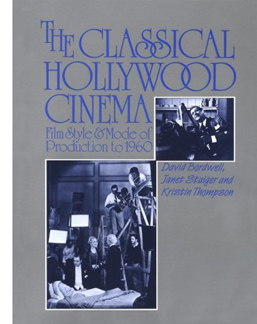 Moreover, once the stylistic menu was standardized, it reinforced and sometimes reshaped the mode of production. At every turn we found these mutual pressures, a mostly stable cycle among tools, artistic techniques, and business practices. Once the studios became established, they needed to outsource the development of new lighting equipment, camera supports, microphones, make-up, and other tools. A supply sector grew up, carrying names like Eastman, Bell & Howell, Mole-Richardson, Western Electric, and Max Factor. But the suppliers had to learn that they couldn’t innovate ad libitum. The filmmakers laid down conditions for what would work onscreen and what would fit into efficient craft routines. In turn, the routines could be adjusted if a new tool yielded artistic advantages. And the whole process was complicated by an element of trial and error. The film community often couldn’t say in advance what would work; it could only react to what the supply firms could provide.
Moreover, once the stylistic menu was standardized, it reinforced and sometimes reshaped the mode of production. At every turn we found these mutual pressures, a mostly stable cycle among tools, artistic techniques, and business practices. Once the studios became established, they needed to outsource the development of new lighting equipment, camera supports, microphones, make-up, and other tools. A supply sector grew up, carrying names like Eastman, Bell & Howell, Mole-Richardson, Western Electric, and Max Factor. But the suppliers had to learn that they couldn’t innovate ad libitum. The filmmakers laid down conditions for what would work onscreen and what would fit into efficient craft routines. In turn, the routines could be adjusted if a new tool yielded artistic advantages. And the whole process was complicated by an element of trial and error. The film community often couldn’t say in advance what would work; it could only react to what the supply firms could provide.
In the late 1920s, for instance, sound recording made the camera heavier than the tripods of the silent era could bear. Supply firms engineered “camera carriages” that could wheel the beast from setup to setup. But this development occurred soon after filmmakers had noticed the expressive advantages of the “unleashed camera” in German films and some American ones. So the camera carriage became a dolly, redesigned to permit moving the camera while filming. It’s not that there weren’t moving-camera shots before, of course, but with the camera permanently on a mobile base, tracking and reframing shots could play a bigger role in a scene’s visual texture. Similarly, studio demands for ways of representing actors’ faces in close-ups forced Technicolor engineers back to their drawing boards again and again. Once the problem of rendering faces pleasant in color was solved, filmmakers could then redesign their sets and adjust their make-up to suit the vibrant three-strip process. And the interaction of work, tools, and style triggered larger cycles of activity. The need to pool information about stylistic demands and technological possibilities helped foster the growth of professional associations and the Academy of Motion Picture Arts and Sciences.
This give-and-take among the studios, the supply sector, and the stylistic norms had never been discussed before, and we couldn’t have done justice to it in separately published books. Nor could isolated studies have easily traced how industrial discourses—the articles in trade journals, the communication among the major players—helped weld the mode of production to artistic choices about filmic storytelling.
The Classical Hollywood Cinema was generously reviewed, in terms that made us feel our hard work had been worth it. Books we’ve written since haven’t been so widely acclaimed. (Nothing like peaking young.) We’re grateful to the reviewers who praised the book, and to the teachers and students who have strengthened their biceps by picking it up to read. Of course there are others who don’t consider the project worthwhile; the TLS reviewer called it “sludge.” Probably nothing we say in the accompanying essay will persuade those readers to take a second look. Without responding to all the criticisms the book received (that would take a book in itself), our accompanying essay tries to position this 1985 project within our current lines of thinking.
We studied how Hollywood routinized its work, but that doesn’t mean that we think division of labor is always alienating. It may produce a much better outcome than do the efforts of a solitary individual. For us, that’s what happened during this rewarding exercise in collaboration.
Our thinking was shaped by many sources; here are some of them.
For André Bazin on “the genius of the system,” see “La Politique des auteurs,” in The New Wave, ed. Peter Graham (New York: Doubleday, 1968), pp. 143, 154, and “The Evolution of the Language of Cinema,” in What Is Cinema? ed. and trans. Hugh Gray (Berkeley: University of California Press, 1967), pp. 23-40. Christian Metz explains the Grande Syntagmatique of the image track in “Problems of Denotation in the Fiction Film,” Film Language, trans. Michael Taylor (New York: Oxford University Press, 1974), 108-146. Raymond Bellour’s essays of the period are available in The Analysis of Film. Thierry Kuntzel’s essay on The Most Dangerous Game was translated into English as “The Film-Work 2,” Camera Obscura no. 5 (1980), 7-68. An important gathering of essays in this line of inquiry is Dominique Noguez, ed., Cinéma: Théorie, lectures (Paris: Klincksieck, 1973).
Noël Burch’s early ideas are set out in Theory of Film Practice, trans. Helen R. Lane (New York: Prager, 1973). Even more important to our project was Noël Burch and Jorge Dana, “Propositions,” Afterimage no. 5 (Spring 1974), 40-66, and Burch’s To the Distant Observer: Form and Meaning in Japanese Film (London: Scolar Press, 1979), available online here.
Raymond Durgnat’s series, “Images of the Mind,” deserves to be republished, preferably online. The most relevant installments for this entry are “Throwaway Movies,” Films and Filming 14, 10 (July 1968), 5-10; “Part Two,” Films and Filming 14, 11 (August 1968), 13-17; and “The Impossible Takes a Little Longer,” Films and Filming 14, 12 September 1968), 13-16. Stephen Heath’s analysis of Touch of Evil may be found in “Film and System: Terms of Analysis,” Screen 16, 1 (Spring 1975), 91-113 and 16, 2 (Summer 1975), 91-113.
Barry Salt’s Film Style and Technology: History and Analysis (London: Starword, 1983) works in comparable areas to CHC, though without our interest in industry-based sources of stability and change. The newest edition is here.
Tino Balio’s courses and his collection The American Film Industry (Madison: University of Wisconsin Press, 1976) had a substantial influence on us. He has been a wonderful friend and guide for us all since the 1970s. Our friendship with Douglas Gomery dates from our early days in Madison. Many conversations, along with his teaching in our program, shaped our thinking. A good summing up his of decades of work on the business and economics of Hollywood is The Hollywood Studio System: A History (London: British Film Institute, 2008).
Some of the stylistic traditions discussed in this entry are discussed in my On the History of Film Style. Several blog entries on this site fill in more details; click on the category “Hollywood: Artistic traditions.”
PS 26 September 2010: Douglas Gomery reminds me that the idea of sampling Hollywood films in an unbiased fashion–one feature of our method in CHC–was suggested to us by Marilyn Moon, economist extraordinaire. I’m happy to thank Marilyn, along with Joanne Cantor and Douglas himself, who helped us devise a sampling procedure.
Actors and set for Blondie Johnson (Warners, 1933).
Research you can bid on
Gift bag from the New Line Cannes party of 2001
Kristin here:
Two days after I returned from “Il Cinema Ritrovato” in Bologna, the “On, Archives!” symposium began here in Madison. The Wisconsin Center for Film and Theater Research turned fifty this year, and this was its celebration. It was held in conjunction with “The Symposium on Broadcasting in the 1930s.” I didn’t attend the whole event, but I dropped in to hear several of the film-related papers.
Among these was Susan Ohmer’s “The Archive in the Age of eBay.” Susan’s an old friend of ours. She wrote a book on the Gallup organization in Hollywood, studies animation, teaches and is an associate provost at Notre Dame, and is married to another old friend and colleague, Don Crafton.
Her topic intrigued me, since I first made my way onto eBay looking for items related to the Lord of the Rings film franchise, which I was researching at the time. It was tremendously useful, and I wanted to hear what 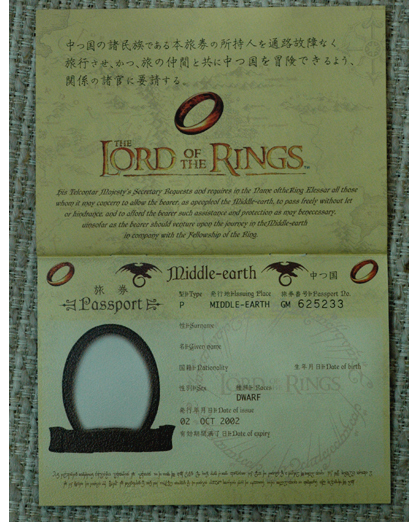 Susan had to say.
Susan had to say.
She started by acknowledging how exciting it can be to work in archives, handling original documents and sometimes finding that smoking-gun piece of evidence you could never get from published sources. Plus for those of us who love books and libraries, just being in an archive can be very pleasant (apart from that darned “pencils only” rule and the occasional snippy archivist).
But, as she pointed out, going to archives can be expensive, given the travel and lodging involved. Moreover, one doesn’t always have the time to study the documents to the extent that one would want to. For some types of evidence, one solution is to acquire the documents yourself.
In Susan’s case, it was Big Little Books, and specifically those based on Walt Disney films and comic books. There were lots of these, but although some archives collect them, most have only a few of the titles. Susan realized that she could actually save herself money by buying them and be able to study them to her heart’s content. Since then she has acquired around ninety on eBay, and I’ll bet she really has saved money in comparison with what the research would have cost. (Moreover, if she eventually sells them for around what she paid, they research would have cost nothing beyond the time and trouble of following auctions, bidding, and paying.)
There’s more to this tactic than just saving money. As Susan said, there’s a pleasure in owning these objects and having the sense of having one’s own little private archive. Very responsibly, she has even invested in archival boxes to store her treasures.
Private collectors, of course, have always been played a valuable service in preserving rare or unique objects. Every painting or ancient artifact that we see in a museum with a “gift of” note on its label probably was enjoyed for years by its owners in their own home. Many a film has been preserved because some people collect old nitrate films. (Yes, nitrate prints do occasionally show up on eBay.) The same is probably true of just about any kind of cultural artifact.
For a long time I had vaguely thought of blogging on the topic of eBay and scholarly research, but I never sat down and thought the subject through. Susan’s paper spurred me to create a rough typology of ways in which one can find what one needs online.
1) The real things
Every now and then an old, original document that really should be in an archive surfaces on eBay. That’s usually because it’s signed by a celebrity.
I remember a few years ago running across a couple of letters from Fritz Lang. I don’t remember what they were about, but they were from the late 1940s and had to do with his work for producer Walter Wanger. I alerted our friend Matthew Bernstein, who had written an important biography of Wanger. He decided not to buy the letters, which as I recall were going for over a thousand dollars each. Devotion to research only goes so far.
Maybe some rich archive like the Harry Ransom Research Center at the University of Texas bought those letters. I suppose archivists keep track of such listings on eBay. If such an institution didn’t buy them, they’re presumably in a private collection somewhere. Similarly, I ran across a letter signed by Buster Keaton; something about renewing his MGM contract, I think. I’m sure such things happen fairly frequently. If an item with really important, unknown contents came online, including material that fit directly into someone’s research, he or she might decide it was worth buying.
But the point is, there are archival-quality historical documents sold on eBay.
2) eBay evidence
Even if one doesn’t want to buy such a document, one can read the contents and make a print-out or take notes. That has to be done quickly, since sometimes these things don’t stay around for long.
I’m working on a book on J. R. R. Tolkien’s novels. There was an excellent volume of Tolkien’s letters published in the 1970s, but it doesn’t contain nearly everything that exists. Such letters come up for sale now and then, always at a high price. It’s fine by me if collectors wind up with these, but I want to get the information before they do. I have tried to make copies of every one I find, unless it’s just a polite reply to a fan. I’ve got a dozen now, two or three of which contain passages relevant to my project.
Sellers tend to make copying difficult, since they superimpose words or logos on the image of the item. They also make the image rather poor in quality. All these stratagems are reasonable, since sellers don’t want people to use these documents to concoct fakes. Still, I have found that with a bit of work with the brightness and contrast in Photoshop, one can usually get legible images. They wouldn’t look good framed, but they’re sufficient for extracting information, though it may take patience and some squinting.
3) Cutting edge
If you’re researching a contemporary subject, the relevant materials might make their way into archives, but not soon enough. When I was writing The Frodo Franchise, I planned a chapter on new methods of studio publicity. Most studios promote big-budget the film through free or cheap means like like brand partnering and press junkets, but I wanted to study how New Line controlled the form that such publicity for The Lord of the Rings took.
One section of the chapter was devoted to the Electronic Press Kit (EPK), which has largely replaced the traditional kit that consisted of printed material, photos, and slides. Some archives hold such traditional kits; the WCFTR has many from old Warner Bros. films. I hope somewhere there are archives collecting today’s EPKs. But even if there are, they wouldn’t have had the ones from The Lord of the Rings yet.
I wanted to analyze the contents of an EPK from one of the franchise installments, and there were only two ways to do that. One option was to get the kit directly from New Line’s publicity department. I did obtain the EPK for The Two Towers from the film’s unit publicist during my first research trip to New Zealand. There weren’t any copies of the Fellowship one left, which may show just how ephemeral these things are. Maybe the Return one wasn’t finished yet.
Fortunately the EPKs for all three parts showed up on eBay, if not frequently, at least often enough that I was able to buy the other two without much of a wait. My analysis in the book was based on the Towers one, since that was the only one I already had by the time I began writing.
(These weren’t the only EPKs put out for the film. There were separate discs issued with additional photography, as well as promotional ones put out to herald each DVD release and to boost the films for Oscar nominations. An archivist’s nightmare. I’m sure I don’t have them all, but all the ones I have except the Towers one came from eBay.)
4) Doesn’t fit in an archival box
Then there are the things public archives don’t collect, as far as I know. From my personal experience, those would include the huge number of franchise products and publicity objects that get made around any big franchise or blockbuster films these days. I needed to see some of these for my work on the Rings franchise. People who study fan culture, like Henry Jenkins, presumably also look at such material.
With luck, the corporate archives of the studios are keeping one copy of everything generated for each film they make. Disney certainly has its own archive, currently closed to outside researchers. I presume a whole run of those Big Little Books exists there.
But for the researcher, finding a cooperative collector or starting a bit of a collection oneself is the only way to see this stuff. So I joined eBay, got myself a PayPal account, and learned the ways of online bidding. I got pretty good at it, if I do say so myself.
I particularly needed Rings items because I assumed I would use some of them as illustrations for the book. As it turned out, I didn’t have space in the book to include very many of the licensed products, especially since I was mainly concentrating on how digital technology has changed franchise products. So there was a chapter on DVDs and one on video games, but not much on things like action figures and board games.
I did run across some very odd items from around the world, some of which I purchased. One of the oddest was this series of Rings-decorated model trucks, sold only in Germany. There are twenty in all, but I thought two would do:
I also bought a small number of franchise items related to the book, many of them pre-dating the film project. The point was to show that the success of the Tolkien’s novel in the 1960s led to a franchise of its own, with action figures, calendars, posters, puzzles, and even early video games. I used a group of these as an illustration. It didn’t include the Toby Bell Gandalf (above left), a 1983 item from the book franchise that I acquired later.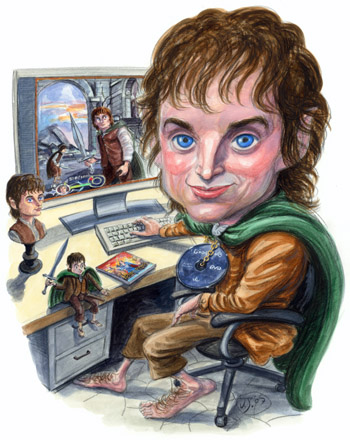
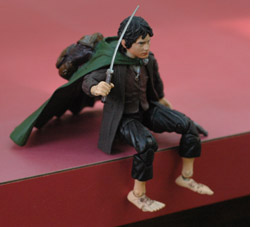 Other franchise goods that I bought ended up being very useful as models for the wonderful caricaturist, Victor Juhasz, when he agreed to do the illustration for the front cover. I had thought about the cover for quite some time as I worked on the book, since a franchise is not exactly an easy thing to convey with one image. I settled on the idea of Frodo playing a video game with himself on the screen, surrounded by franchise items of him: a Sideshow Weta bust, a Toy Biz action figure, and a DVD on the chain around his neck, in place of the Ring. I shipped the bust and action figures to Victor, along with a few of the tie-in books with pictures of Elijah Wood in costume. I also sent one of the video-game strategy books, so that Victor could choose a picture to copy for the monitor screen. He came up with exactly the illustration I had in mind.
Other franchise goods that I bought ended up being very useful as models for the wonderful caricaturist, Victor Juhasz, when he agreed to do the illustration for the front cover. I had thought about the cover for quite some time as I worked on the book, since a franchise is not exactly an easy thing to convey with one image. I settled on the idea of Frodo playing a video game with himself on the screen, surrounded by franchise items of him: a Sideshow Weta bust, a Toy Biz action figure, and a DVD on the chain around his neck, in place of the Ring. I shipped the bust and action figures to Victor, along with a few of the tie-in books with pictures of Elijah Wood in costume. I also sent one of the video-game strategy books, so that Victor could choose a picture to copy for the monitor screen. He came up with exactly the illustration I had in mind.
So now I have a fairly decent collection of Rings-film-related stuff. Maybe someday I’ll offer it to an archive, if any will take it. But my collection is far, far from complete. I don’t know if anyone has absolutely everything, every British lottery ticket with Frodo’s face on it, every paper plate, every mouse pad. But I did meet someone on eBay who probably has come as close as anyone to achieving that goal.
Springlering Lord of the Rings Virtual Museum and Shop
I mentioned that private collections often serve as archives, and this is especially important when it comes to ephemeral items. I first met Melinda Burnett (aka Springlering) online when I bought some items from her. I mentioned my book project, and she sent me information about buying on eBay, who the major collectors were, and so on.
I recommend this, by the way. If ever you buy something on eBay related to research, mention your project to the seller when you pay. There’s always a little box where you can write messages about special shipping instructions or whatever. By telling sellers about my book, I got lots of information, plus an offer from a bookstore owner in Queenstown, New Zealand, to hold a signing of my book in his shop. (Alas, I never did book signings in New Zealand.) These people are often friendly and even excited at the idea that something you purchase from them might end up in a book. Several of them asked me to notify them when the book came out. I emailed these people when it did. Some of them probably bought copies.
But back to Springlering. She herself is one of the major Rings collectors, going far beyond the ordinary T-shirts, action figures, and cardboard standees. She has the four Japanese promotional “Middle-earth passports” (see the dwarf one, above right), the French fèves (literally, “beans,” little ceramic prizes hidden inside bakery goods; see below), the Polish Nutella drinking glasses, the 2004 Mardi Gras Elijah Wood medallion, and so much more. Basically she sells her duplicates in order to be able to afford new items (or at least that was still the case when the trilogy was still current).
Not only is she a collector, but she has photographed many of the items in her 6000+ collection and put them on the internet as a virtual museum. She’s still adding to it. I just wish she had had it up when I was researching my book. There must be other enthusiasts in other fandoms who do similar things.
Springlering has left eBay (and gives her reasons in the blog on her site) and now sells directly in her online shop, where you, too, can buy fèves while supplies last. According to the “about” page, she has given talks on collectibles at fan events. If I had been doing more with the licensed Rings products, I would have been wise to interview her.
I should note that this post doesn’t just apply to eBay. There are other online auctions or sellers. The stores that sell on the American Book Exchange, for example, sometimes have original letters, drawings, and other sorts of film memorabilia on offer.
May 3, 2017: These and other items I obtained while preparing The Frodo Franchise now reside in the Raynor Memorial Libraries of Marquette University, Milwaukee. The comprise the “Kristin Thompson Tolkien Fandom Collection,” a subset of the much larger “J. R. R. Tolkien Collection.” Thanks to Archivist William Fliss and his team for recognizing the value of collecting these kinds of peripheral objects and for allowing my collection to reside in the shadow of the Master.
A display case for fèves: “Depart on the quest for fèves” (“A delight for both collectors and dentists!” as Springlering says)












